Abstract
In this paper we consider an unusual structure, twice observed at the magnetopause of Mercury, and called the “Double Magnetopause”. Presumably, it is associated with a current sheet created by Na+ ions. Two alternative scenarios are considered. The first one: Sodium ions prevail outside the Hermean magnetosphere. The second: Sodium ions predominate inside the magnetosphere of Mercury. These ions have been observed inside and outside the magnetosphere. We analyze what Na+ density excess can be sufficient for creation of a wide diamagnetic magnetopause current and on which side of the magnetopause this current is located. For each scenario, two directions of the north-south (Z) component of the solar wind magnetic field are considered.
1. Introduction
The time-dependent sodium exosphere surrounds Mercury. The sodium exosphere of Mercury depends on solar radiation and solar wind plasma, as well as on micrometeoroids flux. Different ionization processes lead to the creation of Na+ ions inside and outside the Hermean magnetosphere. Mercury’s exosphere was formed due to thermal and impact vaporization, photon-stimulated and electron-stimulated desorption, ion sputtering, and interaction with the solar wind [1,2,3]. All these processes are interconnected and affect each other. Interaction with the solar wind and the interplanetary magnetic field (IMF) for Mercury is very strong, as it is located close to the Sun and possesses a global weak magnetic field; thus, reconnection occurs almost constantly (e.g., [4]). Potter and Morgan [5] found that the emissions of sodium and potassium at high latitudes are more intense and that sodium is more prevalent in the exosphere of Mercury than potassium. Some sodium excess was observed also at the subsolar region [2]. The picked-up sodium ions are accelerated in the magnetosheath due to the interaction with the disturbed solar wind; they partially return inside the magnetosphere [6]. These energetic heavy ions are a source of hot Na+ inside the magnetosphere [7]. Here we consider different cases when sodium ions prevail outside or inside the magnetosphere and when the Bz interplanetary magnetic field (IMF) component is northward or southward. We consider the possibility of the generation of sodium ion diamagnetic current at the Hermean magnetopause dependent on these conditions.
2. Sodium Ions Predominate out of the Magnetosphere
Sarantos et al. [7] emphasized that MESSENGER during its first flyby observed a maximum of sodium ions close to the planet and the next maximum in the magnetosheath. The authors suggested that out of the magnetosphere, the pickup sodium ions can reach the energy of ~10–100 keV. In this section, we suppose that the difference between Na+ ion densities in the magnetosheath and magnetosphere nmsh − nmsph = nmsh0 > 0. The characteristic average values of the Z IMF component at the orbit of Mercury are suggested to be ~ ±30 nT [8].
2.1. Northward IMF
Here we consider the case when sodium ions predominate out of the magnetosphere, and IMF is northward. Northward IMF was observed, for example, during the first MESSENGER flyby on 14 January 2008, when the spacecraft left the dawn magnetosphere. Slavin et al. [9] noted that at ~19:10:35 and at 19:14:15 UTC on 14 January 2008, two current sheets of small thickness and the same orientation were observed at the dawn-side magnetosphere. One of them was placed at the magnetopause, and the other closer to the planet. Between them, the broad zone of decreased Bz, named D-BL (dayside boundary layer) or Planetary Ion Boundary Layer, was recorded (see, for example, Figure 4A from [9]). The authors supposed that this current was carried by the sodium ions penetrating from the magnetosheath. Here we analyze what excess of Na+ ions should be in the magnetosheath relative to the magnetosphere to produce the Planetary Ion Boundary Layer in such structure.
To interpret the observed D-BL we use the analytical approach suggested by Belenkaya [10] for the Earth and applied to Mercury for the first MESSENGER flyby by Belenkaya and Pensionerov [11]. We suppose that excess of Na+ ions in the magnetosheath could create a magnetization diamagnetic current Jmsh on the magnetospheric side of the magnetopause at the equatorial latitudes (Figure 1). This current Jmsh is generated by those arcs of the Larmor circles of excess magnetosheath sodium ions, which are placed in the magnetospheric side of the magnetopause. This current is uncompensated by the neighbor magnetospheric ions and is directed from dawn to dusk in the considered case [11]. As Bz components on both sides of the magnetopause are parallel to each other, the sense of gyrorotation is conserved at the magnetopause. Figure 1 schematically presents the used approach.
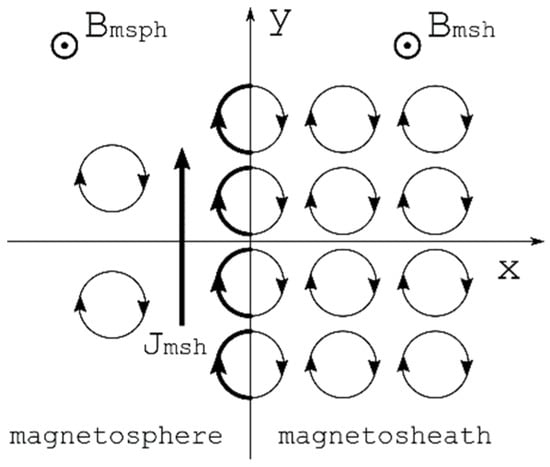
Figure 1.
The magnetospheric equatorial plane is presented in the vicinity of the magnetopause considered to be a thin layer coinciding with the Y-axis; the IMF is northward. The X-axis is directed sunward (positive X corresponds to the magnetosheath and negative to the magnetosphere). Jmsh is the diamagnetic current, which we consider to be caused by the positive difference of sodium ion densities in the magnetosheath and magnetosphere (following Figure 2 from [11]).
Diamagnetic current Jmsh caused by the space inhomogeneity of the plasma is directed along Y axes from dawn to dusk (the Z-axis is directed parallel to the magnetospheric magnetic field near the noon magnetopause). Belenkaya [10] found the distribution function F(x) for the selected ion species. F(x) was chosen to be equal to Cf(x,φ)δ(V − Vth)δ(θ − θ0), where C is a constant dependent on boundary conditions; f(x,φ) is a step-cutoff function that limits the penetration of ions on the depth of their Larmor diameter (2) from one side of the magnetopause to the other; φ is an angle between X-axis and vector V measured to Y direction; Vth is a thermal velocity of ions; θ is a polar angle from axis Z of the velocity vector V; θ0 = π/2; δ is a delta function. Equations for F(x) are given in [10]. These equations allowed us to determine the density of ions n (as distribution function moment), plasma pressure P, and current density , given by Equation (1)
for −2< x < 0.
The magnetic field B of the current with density jmsh is given by Equation (2):
The one-dimensionality of the considered model allows us to write:
The magnetic field caused by the current inside the magnetosphere can be found by integration of Equation (3):
for −2 < x < 0.
Here
where Bmsh0 is the average magnetic field in the magnetosheath; Bmsph0 is the average magnetic field inside the magnetosphere out of the D-BL layer; ρmsh is the Larmor radius of sodium ions penetrating from the magnetosheath on the depth ≤2ρmsh into the magnetosphere. From Figure 4A of Slavin et al. [9], it follows that Bmsh0 ~30 nT and Bmsph0 ~90 nT, which gives B0 = −60 nT for the considered case of northward IMF (e = −1.6 10−19 s A is the electron charge; μ0 = 4π⋅10−7 kg m s−2A−2 is the magnetic permeability of the vacuum; k = 1.38 × 10⁻²³ kg m2 s−2 is the Boltzmann constant, and (2kTmsh/mmsh)1/2 is the thermal ion velocity). Mass of the Na+ ion is mmsh = 3.8 × 10−26 kg.
From the Slavin et al. [9] data, it follows that the width of the D-BL layer in X direction L ~927 km and, consequently, ρmsh = L/2 = 463 km (Mercury radius RM = 2440 km). From the formula for ρmsh:
where and zNa+ = 1. We can obtain the velocity of the ions coming from the magnetosheath and having this gyroradius: VNa+ ~ 176 km s−1.
Diamagnetic current Jmsh is located inside the magnetosphere when sodium ions predominate in the magnetosheath (see Figure 1). Figure 2 presents calculations by Equations (4) and (5) of Bz for different values of nmsh0 > 0. In Figure 4A from [9], it is seen that at the edges of the D-BL there are two narrow jumps of Bz. One of them is interpreted as the usual proton thin current sheet at the magnetopause, the other one, deeper in the magnetosphere, is supposed by Mϋller et al. [12] to be due to the proton pressure gradients. During the first MESSENGER flyby, the sharp decrease of Bz at the magnetopause, when MESSENGER exited into the magnetosheath, was ~30 nT, while the second sharp decrease, when the spacecraft entered the D-BL, was of the order of ~20 nT. We consider this case a typical one under the taken conditions. The calculation results for nmsh0 ~2 cm−3 better describe the observations of a Bz smooth decrease with an increase of X for −2ρmsh < x < 0 between two sharp drops at both edges of the D-BL.
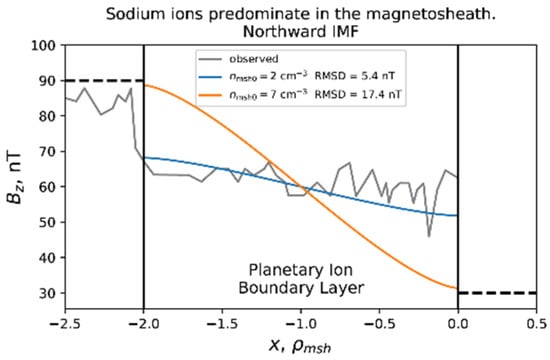
Figure 2.
Bz near magnetopause (located at X = 0) for −2ρmsh < x < 0 in a case when the sodium ions dominate in the magnetosheath, and IMF is northward. Calculations of Bz by Equations (4) and (5) for nmsh0 = 2 cm−3 are shown in blue and for nmsh0 = 7 cm−3 in orange. Black horizontal dashed lines correspond to the boundary conditions: Bmsh0 ~30 nT and Bmsph0 ~90 nT. Grey curve demonstrates the MESSENGER magnetic field measurements during the first flyby presented by Slavin et al. [9] in the zone of diamagnetic decrease.
To better support our conclusions based on the magnetic field data, we quantified the comparison between the model and the observations. We calculated the root-mean-squared deviation (RMSD) of the model with different ion densities from the observed magnetic field. RMSD is now shown in Figures 2, 4, 6 and 8.
2.2. Southward IMF
Figure 3 schematically shows the generation of the current Jmsh by the excess of the sodium ions in the magnetosheath for Bz IMF < 0. For southward IMF, the direction of the current carried by Na+ ions in the magnetosphere caused by the excess of sodium ions beyond the magnetopause is the same as for the northward IMF. Because the reason for this current is the same in both cases, and the Bz direction in the magnetosphere does not change. Consequently, for an excess of sodium ions in the magnetosheath relative to the magnetosphere, regardless of the Bz IMF orientation, the current in the magnetosphere has the same direction (to the dusk).
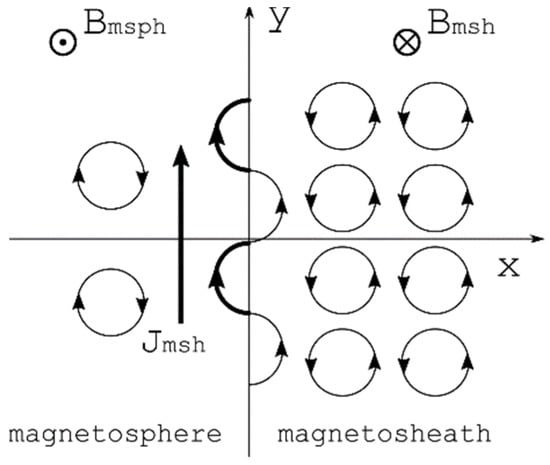
Figure 3.
The same as in Figure 1, but for the southward IMF.
Thus, associated with Jmsh is again given by Equations (4) and (5). We can consider the second MESSENGER flight as an example of the case when the IMF was southward [13]. Two first flybys were near-equatorial. In Figure 2 from Slavin et al. [13], it is seen that similar to the previous case, a diamagnetic decrease is observed just before the magnetopause during the spacecraft’s exit from the magnetosphere on 6 October 2008 from 08:44:26 to 08:49:11 UTC when intersection with the magnetopause happened. At the magnetopause and just beyond it, the strong FTE was observed. The width of the depression layer in X direction was L ~1513 km. If we consider that this layer is created by the sodium ions current, then L ~2ρmsh, and ρmsh = 756 km. From Equation (6), it follows that VNa+ ~286.5 km s−1.
Calculations of Bz generated by Jmsh are shown in Figure 4 for southward IMF. We take the following values for the north-south magnetic field component out of the D-BL: Bmsh0 ~70 nT at the right edge of the depression layer and Bmsph0 ~90 nT at its left (inner) edge, which gives B0 = −80 nT for southward IMF (see Equation (5)).
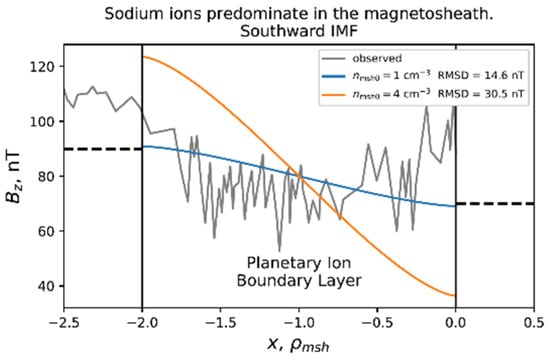
Figure 4.
The same format as in Figure 2, but for southward IMF. Calculations of Bz by Equations (4) and (5) for nmsh0 = 1 cm−3 are shown in blue and for nmsh0 = 4 cm−3 in orange. Grey curve demonstrates the MESSENGER magnetic field measurements during the second flyby presented by Slavin et al. [13] in the zone of diamagnetic decrease.
Figure 4 demonstrates a comparison of calculations by Equations (4) and (5) with the measurements of Bz during the second MESSENGER flyby presented by Slavin et al. [13]. From this figure, it follows that the density excess of nmsh = 1 cm−3 gives a suitable result.
3. Sodium Ions Predominate in the Magnetosphere
On-ground observations show that the denser exosphere of Mercury is in the dayside mid-high latitudes (near the cusp footprints). However, sometimes a density increase occurs in the subsolar exosphere. The last case is most interesting for us. Here, we consider the case when the difference between the densities of Na+ inside the magnetosphere and in the magnetosheath is positive: nmsph − nmsh = nmsph0 > 0.
Using the approach described by Belenkaya [10], we can conclude that if a sodium ion excess is in the magnetosphere, then the current carried by these ions will be in the magnetosheath, just beyond the magnetopause.
3.1. Northward IMF
Raines et al. [14] mentioned that in the cusp region, Na+ ions have a rather high energy of ~2.7 keV, while in the dayside magnetosphere their energy is of the order of keV. We can find velocity corresponding to the keV thermal energy.
where TNa+ is the temperature. Magnetospheric keV sodium ions penetrating the magnetosheath have VNa+th = (2ENa+/mNa+)1/2 = 92 km/s (here ENa+ = kTNa+), and their Larmor radius (Equation (6)) in the magnetosheath magnetic field with the average strength of the order of ~30 nT is ρmsph ~700 km. Generation of a diamagnetic magnetopause current for the case, when sodium ions predominate in the magnetosphere and IMF is northward is shown in Figure 5.
VNa+ th = (2kTNa+/mNa+)1/2

Figure 5.
The same as in Figure 1, but for the case when the sodium ions are predominant in the magnetosphere.
The sodium ion current Jmsph in this case is located in the magnetosheath and is directed to the dawn. The magnetic field generated by this current is
for 0 < x < 2ρmsph0.
where Bmsh1 and Bmsh2 are Bz values at the inner and outer edges of the supposed sodium ion current, respectively.
The current Jmsph oriented to dawn creates Bz which should grow in the magnetosheath with increasing X. Since we did not find the corresponding observations described in the literature, we can take arbitrary characteristic values for the magnetic field at the edges of the zone of the expected magnetic field decrease. We chose the characteristic average IMF Bz value just beyond the magnetopause Bmsh1 ~30 nT and the value of Bmsh2 ~50 nT at the outer edge, which gives B0 = −40 nT for northward IMF.
Calculations using Equations (8) and (9) are demonstrated in Figure 6, which shows that cm−3 gives a suitable result.
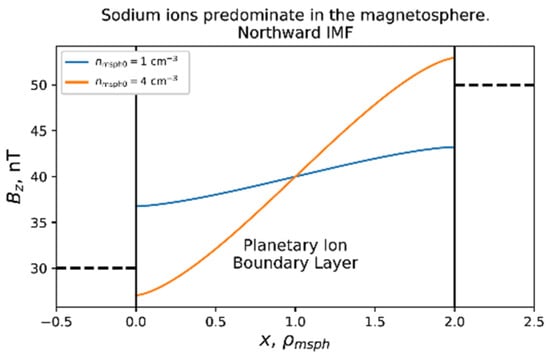
Figure 6.
Bz near magnetopause (located at X = 0) for 0 < x < 2ρmsph in the case when the sodium ions dominate in the magnetosphere, and IMF is northward. The calculations of Bz by Equations (4) and (5) for nmsph0 = 1 cm−3 are shown in blue and for nmsph0 = 4 cm−3 in orange.
3.2. Southward IMF
If sodium ions predominate in the magnetosphere, the diamagnetic current should be located in the magnetosheath independently of the Bz IMF. This case is shown in Figure 7 for southward IMF.
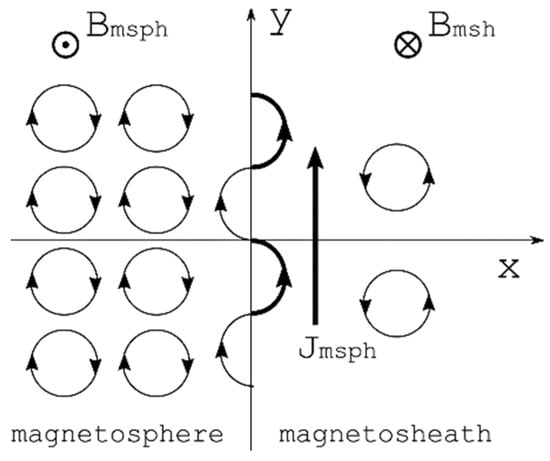
Figure 7.
The same as in Figure 3, but for the case when the sodium ions predominate in the magnetosphere.
The Bz generated by Jmsph in the case of southward IMF is given by Equation (4) but for 0 < x < 2ρmsph0 (in the magnetosheath). If we assume that the velocity in the magnetosheath of the keV thermal sodium ions is Vth = 92 km s−1, as in the previous case, then at the same magnetosheath magnetic field strength ~30 nT, the gyroradius is ρmsph = 700 km. In Equation (5), we chose the following values for Bz IMF at the edges of the expected magnetic decrease zone: Bmsh0 = −30 nT, Bmsph0 ~90 nT, and consequently, B0 = −30 nT.
From Figure 8, it follows that, in this case, to obtain a decrease of Bz corresponding to the accepted boundary conditions for the magnetic field at the edges of the expected current generated by sodium ions, the excess of Na+ in the magnetosphere should be of the order of 15 cm−3.
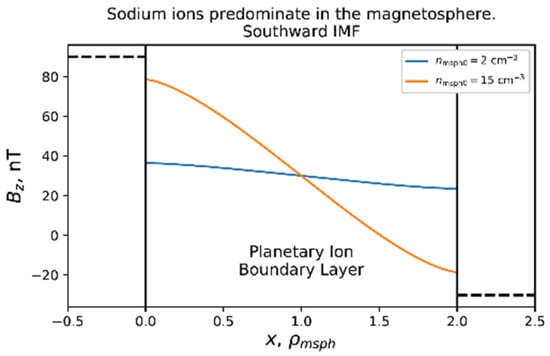
Figure 8.
Bz near magnetopause (located at X = 0) for 0 < x < 2ρmsph in the case when the sodium ions dominate in the magnetosphere, and IMF is southward. The calculations of Bz by Equations (4) and (5) for nmsph0 = 2 cm−3 are shown in blue and for nmsph0 = 15 cm−3 in orange.
The magnetic field structure investigated in the last two cases was not observed in the Hermean magnetosheath, probably, because the other MESSENGER orbits were located mainly along the Z-axis, perpendicular to the equatorial plane, which did not allow observing the equatorial magnetosheath near the magnetopause during a relatively long time, or the assumed boundary values of Bz have been chosen to be too rough.
4. Conclusions
Using the analytical approach developed for the Earth by Belenkaya [10] and applied to Mercury for the first MESSENGER flyby by Belenkaya and Pensionerov [11], we consider the possibility of constructing a wide current at the Hermean magnetopause carried by sodium ions. We showed that if there is an excess of Na+ ions in the magnetosheath (magnetoshere), then such a current is on the magnetospheric (magnetosheath) side of the magnetopause. If Na+ ions prevail outside the magnetosphere, this current is directed from dawn to dusk independently of the north-south IMF component orientation. When sodium ions prevail in the magnetosphere, the sodium ions current is directed to the dusk for the southward IMF and to the dawn for the northward IMF.
To explain the “double magnetopause” [9,13] observed during the first two MESSENGER flights, presumably caused by the participation of the Na+ current, according to our calculations, the excess of sodium ions in the magnetosheath should be on the order of 1–2 cm−3. In the opposite case (when sodium ions prevail in the magnetosphere), the excess of Na+ in the magnetosphere should be ~4 cm−3 for northward IMF and ~15 cm−3 for southward IMF to create a sodium current out of the magnetopause for the average Bz values in the magnetosheath. Such a predicted structure was not observed, probably because MESSENGER did not intersect the magnetopause along the equatorial plane during a sufficient time on the next trajectories. Another reason could be that the assumed boundary values for Bz were too rough. Perhaps a future BepiColombo mission will be able to answer these questions. It is assumed that the influence of the solar wind will be studied in more detail since one spacecraft of the BipiColombo mission will be in the solar wind out of the magnetosheath, while the other in the magnetosphere of Mercury [15].
Author Contributions
Conceptualization, E.B. and I.P.; methodology, E.B., D.P., I.P., I.A.; software, I.P.; validation, I.P.; formal analysis, E.B., I.P., I.A., D.P.; investigation, E.B., I.P., I.A., D.P.; writing—original draft preparation, E.B.; writing—review and editing, E.B., I.P., I.A., D.P.; visualization, I.P.; supervision, E.B.; project administration, E.B.; funding acquisition, I.A. All authors have read and agreed to the published version of the manuscript.
Funding
This research was funded by RFFI, grant number 21-52-12025 of RF.
Informed Consent Statement
Not applicable.
Data Availability Statement
Not applicable.
Conflicts of Interest
The authors declare no conflict of interest.
References
- Milillo, A.; Wurz, P.; Orsini, S.; Delcourt, D.; Kallio, E.; Killen, M.R.; Lammer, H.; Massetti, S.; Mura, A.; Barabash, S.; et al. Surface-exosphere-magnetosphere system of Mercury. Space Sci. Rev. 2005, 117, 397–443. [Google Scholar] [CrossRef]
- Killen, R.; Cremonese, G.; Lammer, H.; Orsini, S.; Potter, A.E.; Sprague, A.L.; Wurz, P.; Khodachenko, M.L.; Lichtenegger, H.I.M.; Milillo, A.; et al. Processes that Promote and Deplete the Exosphere of Mercury. Space Sci. Rev. 2007, 132, 433–509. [Google Scholar] [CrossRef] [Green Version]
- Seki, K.; Nagy, A.; Jackman, C.M.; Crary, F.; Fontaine, D.; Zarka, P.; Wurz, P.; Milillo, A.; Slavin, J.A.; Delcourt, D.C.; et al. A review of general physical and chemical processes related to plasma sources and losses for solar system magnetospheres. Space Sci. Rev. 2015, 192, 27–89. [Google Scholar] [CrossRef]
- Milillo, A.; Fujimoto, M.; Murakami, G.; Benkhoff, J.; Zender, J.; Aizawa, S.; Dósa, M.; Griton, L.; Heyner, D.; Ho, G.; et al. Investigating Mercury’s Environment with the Two-Spacecraft BepiColombo Mission. Space Sci. Rev. 2020, 216, 93. [Google Scholar] [CrossRef]
- Potter, A.E.; Morgan, T.H. Sodium and potassium atmospheres of Mercury. Planet. Space Sci. 1997, 45, 1. [Google Scholar] [CrossRef]
- Yagi, M.; Seki, K.; Matsumoto, Y.; Delcourt, D.; Leblanc, F. Global structure and sodium ion dynamics in Mercury’s magnetosphere with the offset dipole. J. Geophys. Res. Space Phys. 2017, 122, 11. [Google Scholar] [CrossRef]
- Sarantos, M.; Slavin, J.A.; Benna, M.; Boardsen, S.A.; Killen, R.M.; Schriver, D.; Trávníček, P. Sodium-ion pickup observed above the magnetopause during MESSENGER’S first Mercury flyby: Constraints on neutral exospheric models. Geophys. Res. Lett. 2009, 36, L04106. [Google Scholar] [CrossRef]
- Slavin, J.A.; Holzer, R.E. The effect of erosion on the solar wind stand off distance at Mercury. J. Geophys. Res. 1979, 84, 2076–2082. [Google Scholar] [CrossRef]
- Slavin, J.A.; Acuña, M.H.; Anderson, B.J.; Baker, D.N.; Mehdi Benna, M.; Gloeckler, G.; Gold, R.E.; Ho, G.C.; Killen, R.M.; Korth, H.; et al. Mercury’s magnetosphere after MESSENGER’s first flyby. Science 2008, 321, 85–89. [Google Scholar] [CrossRef] [PubMed]
- Belenkaya, E. Currents at the subsolar low shear magnetopause. J. Geophys. Res. 2001, 106, 25437–25450. [Google Scholar] [CrossRef]
- Belenkaya, E.; Pensionerov, I. What density of magnetosheath sodium ions can provide the observed decrease in the magnetic field of the “Double Magnetopause” during the first MESSENGER flyby? Symmetry 2021, 13, 1168. [Google Scholar] [CrossRef]
- Mϋller, J.; Simon, S.; Wang, Y.-C.; Motschmann, U.; Heyner, D.; Schule, J.; Ip, W.-H.; Kleindienst, G.; Pringle, G. Origin of Mercury’s double magnetopause: 3D hybrid simulation study with A.I.K.E.F. Icarus 2012, 218, 666–687. [Google Scholar] [CrossRef]
- Slavin, J.A.; Acuña, M.H.; Anderson, B.J.; Baker, D.N.; Mehdi Benna Boardsen, S.A.; Gloeckler, G.; Gold, R.E.; Ho, G.C.; Korth, H.; Krimigis, S.M.; et al. MESSENGER observations of magnetic reconnection in Mercury’s magnetosphere. Science 2009, 324, 606–610. [Google Scholar] [CrossRef] [PubMed]
- Raines, J.M.; DiBraccio, G.A.; Cassidy, T.A.; Delcourt, D.C.; Fujimoto, M.; Jia, X.; Mangano, V.; Milillo, A.; Sarantos, M.; Slavin, J.A.; et al. Plasma Sources in Planetary Magnetospheres: Mercury. Space Sci. Rev. 2015, 192, 91–144. [Google Scholar] [CrossRef] [Green Version]
- Heyner, D.; Auster, H.-U.; Fornacon, K.-H.; Carr, C.; Richter, I.; Mieth, J.Z.D.; Kolhey, P.; Exner, W.; Motschmann, U.; Baumjohann, W.A.; et al. The BepiColombo Planetary Magnetometer MPO-MAG: What Can We Learn from the Hermean Magnetic Field? Space Sci. Rev. 2021, 217, 52. [Google Scholar] [CrossRef]
Publisher’s Note: MDPI stays neutral with regard to jurisdictional claims in published maps and institutional affiliations. |
© 2021 by the authors. Licensee MDPI, Basel, Switzerland. This article is an open access article distributed under the terms and conditions of the Creative Commons Attribution (CC BY) license (https://creativecommons.org/licenses/by/4.0/).